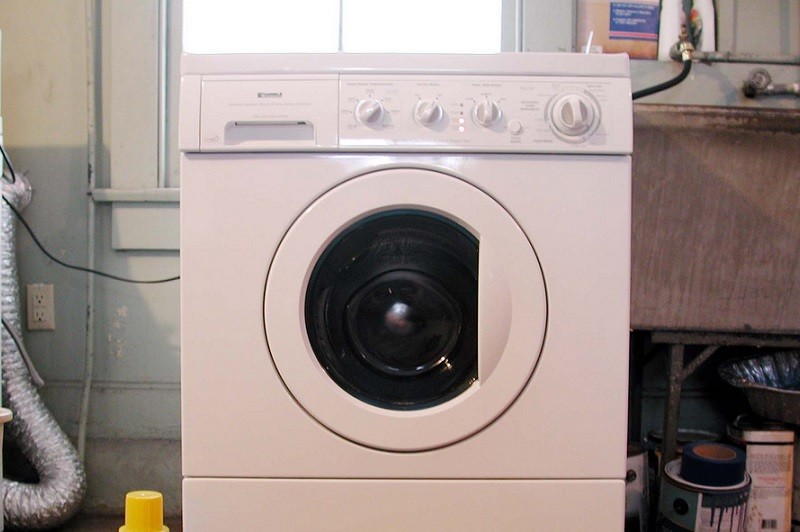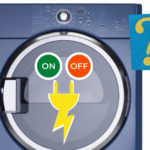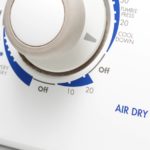It won’t come as a surprise to hear that tumble dryers get warm when they’re in use. After all, this is how wet clothes get dried.
However, there’s a difference between a nice toasty temperature coming out of your dryer, and a roasting temperature emanating from your dryer as it works its magic.
The significant difference being that such soaring temperatures aren’t supposed to be given off by condenser tumble dryers.
And when these high temperatures come into play, they’re usually a sure sign that there’s something wrong with the machine.
But what causes this heat to occur and how do you solve the problem? Keep on reading to find out why your condenser tumble dryer is getting too hot.
How To Tell If Your Dryer Is Actually Overheating

If you think your condenser tumble dryer could potentially be overheating, you should not ignore the warning signs the appliance is giving you. Doing so could be quite disastrous for you, so keep an eye out for signals like the ones below:
- Tumble dryer feels hotter than usual to touch
- Tumble dryer shuts down randomly
- A burning smell is coming from the tumble dryer
- An error code is showing up on the tumble dryer (not applicable to all makes and models)
If you see any of these signs, you should stop using your tumble dryer immediately. You should then cut the power to the dryer and remove any laundry from the machine.
After you’ve done this, you should inspect the machine for potential issues (like the ones listed below).
And if you can’t sort the problem out yourself, you should call a professional in to help you out.
But don’t use the dryer during this time. Leave it alone.
If your condenser dryer is getting too hot, you need to get to the root of the problem as soon as possible! Read on to understand why your condenser dryer may be getting too hot.
Cause 1: The Heating Element in the Tumble Dryer Is Faulty
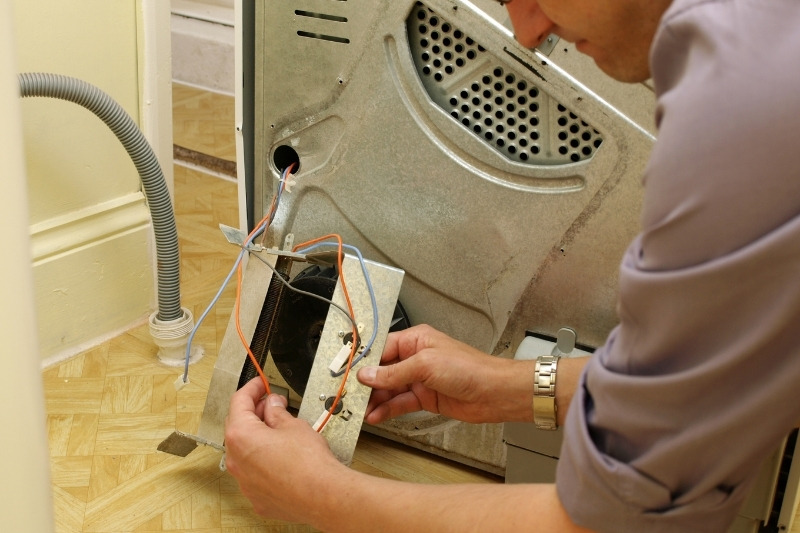
A common problem with tumble dryers is that the heating element inside the machine breaks down over a period of time.
Generally, when this happens, the drum inside the dryer still spins around and the tumble dryer does complete a cycle, but the heating element doesn’t heat up/cool down the appliance as it should.
When a heating element malfunctions, it can raise the temperature inside the machine to an extremely hot one. This type of temperature is abnormally high and it isn’t suitable for a lot of laundry or the machine itself.
Note: In many cases, when a heating element stops working correctly, the element will not heat the dryer up at all, so laundry will come out wet.
To resolve this issue, you will need to:
- Turn the power off and unplug the dryer completely.
- Pull the tumble dryer out of its slot, so you can reach the back of the machine.
- Locate the heating element – it’s usually housed behind some large metal sheeting.
- You will need to remove this section of the dryer – consult your user manual for details.
- Once the heating element is exposed, you can check it over for breaks.
- You will also need to use a multimeter to measure the electricity value that’s going through the wires in the heating element.
- The ideal reading for your tumble dryer is 20-50 ohms.
- If you see a reading on either side of these figures, you’ll know that there’s a problem with the heating element.
- The heating element will need to be replaced.
- You can do this yourself by purchasing the correct part for your machine, and following a tutorial on how to fit the new element. Or you can call a professional in to help you with the task.
Cause 2: Thermostat Has Malfunctioned or Broken in the Tumble Dryer
The thermostat inside the tumble dryer is responsible for measuring and regulating the temperature inside the machine during each cycle.
However, when the thermostat begins to malfunction, the thermostat will not give accurate temperature readings to other parts in the dryer.
This then results in the tumble dryer getting too hot during cycles (it can also make the dryer too cold too).
A dryer with a broken thermostat is quite dangerous because the machine isn’t actually able to control how warm it gets.
This is how you solve the issue:
- You will need to locate the thermostat. Use your user manual to help you out with the task.
- The thermostat isn’t usually very big and can be found at the back of the dryer.
- You will need to remove and replace the thermostat.
- It is possible to replace a thermostat by yourself, however, if you’re unsure you can call in a professional.
- Be sure to watch plenty of tutorials before you attempt this job by yourself.
Cause 3: Condenser Box Needs to Be Cleaned
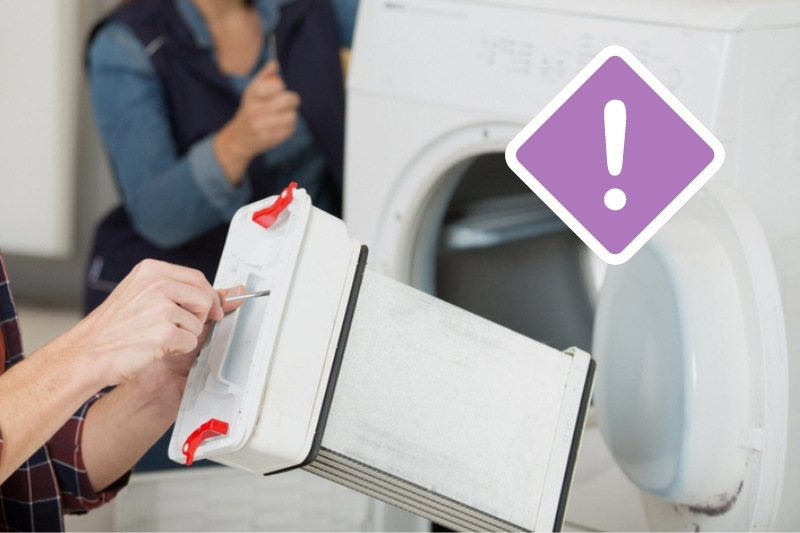
Dirty condenser boxes can really hinder how a condenser dryer performs overall.
Not only can a grotty box make the dryer heat up too much, because pressure and blockages start to occur throughout the machine, because the grime isn’t cleaned away.
But stinky condenser boxes can also be very smelly, can impact how long cycles take to run, and any fluff that’s caught up inside the box, or the box’s home, can be hazardous.
This is how you resolve the issue:
You clean the condenser box. And you need to do it regularly.
It’s very simple to clean a condenser box, and all you need to do is:
- Cut the power to the appliance and unplug it.
- Remove the box – check your user manual to see exactly how you need to do this – there are usually some hooks that you need to open.
- Hold the condenser box under a running tap – allow the water to clean away the grime.
- Remove any obvious dirt that’s clinging onto the condenser box.
- Hoover out the empty space where the condenser box goes in the tumble dryer.
- Allow the box to dry naturally.
- Replace the condenser box and close all the latches back up.
For an in depth guide on how to clean a condenser box, check out this video or follow our step-by-step guide to cleaning a condenser box.
Cause 4: The Water Tank in the Tumble Dryer Is Full
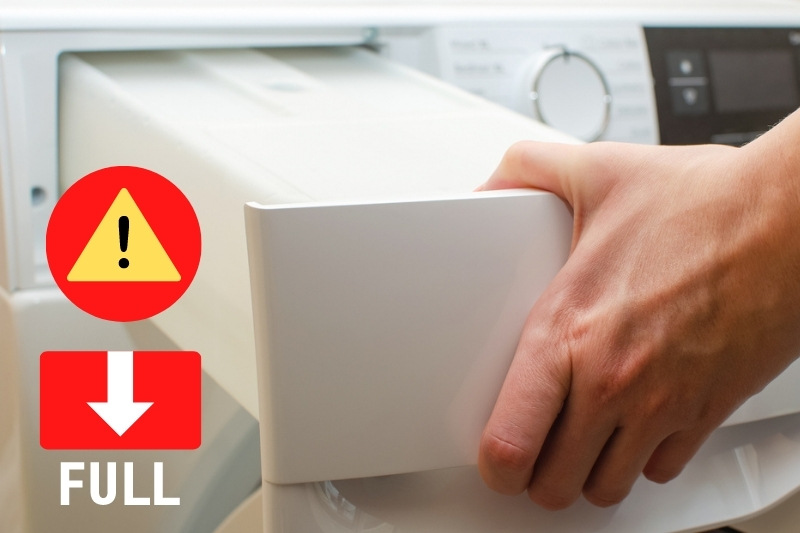
Before you use a condenser tumble dryer you should make a habit of checking and emptying the water tank.
If you allow the tank to fill up to bursting point, the remaining water that is trying to get to the tank won’t have anywhere to go.
The stagnant water, therefore, remains in the dryer, and in turn, this puts pressure on the tumble dryer, and it starts to heat up.
To solve this problem, you need to:
All you need to do is remove the tank and pour the water down the drain.
Make a habit of emptying the water tank in your tumble dryer at the end of every cycle. And check to see if the water tank is clear before starting a new cycle.
Cause 5: The Filter Is Dirty
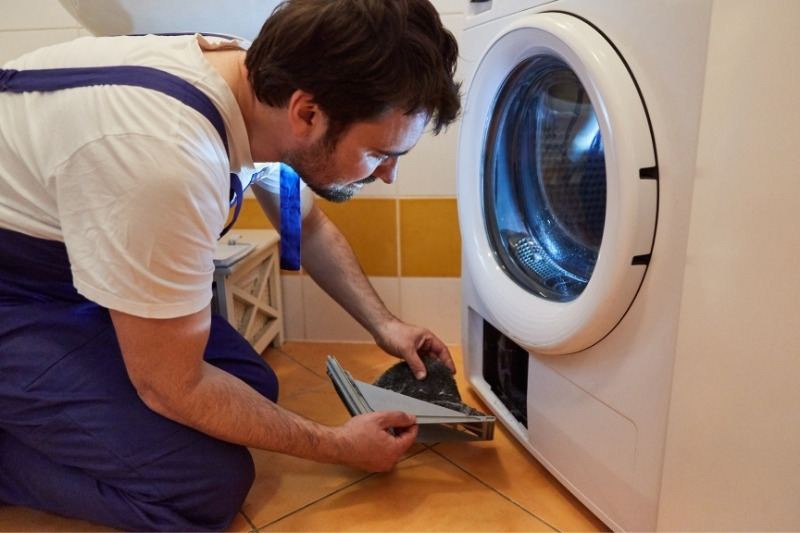
The filter inside a dryer is there to catch all the lint, fibres and hair that come off clothes as they get dried.
It’s actually unbelievable to see how much dirt the filter is able to catch after just one drying cycle.
Which is why it’s imperative that you clean the filter after every single cycle.
A clogged filter not only puts needless pressure on the dryer, but the grime that the filter should catch starts to work its way back into the appliance, and starts to clog the machine up if it doesn’t get trapped by the filter, and this is very dangerous.
Such clogging can put strain on the inner workings of the machine, and in turn, the dryer can start to heat up.
To resolve this issue, you need to:
Clean the filter out after every single use. And when the filter is out of the machine, use your vacuum cleaner’s thinnest tool to hoover the gap where the filter usually sits.
You won’t believe how much mess gets left behind in the tiny gap.
Filters are typically located just inside of the machine, near the door. They’re super easy to remove and to replace back in the appliance once they’ve been cleaned.
Cause 6: The Tumble Dryer Is Housed in an Unsuitable Environment
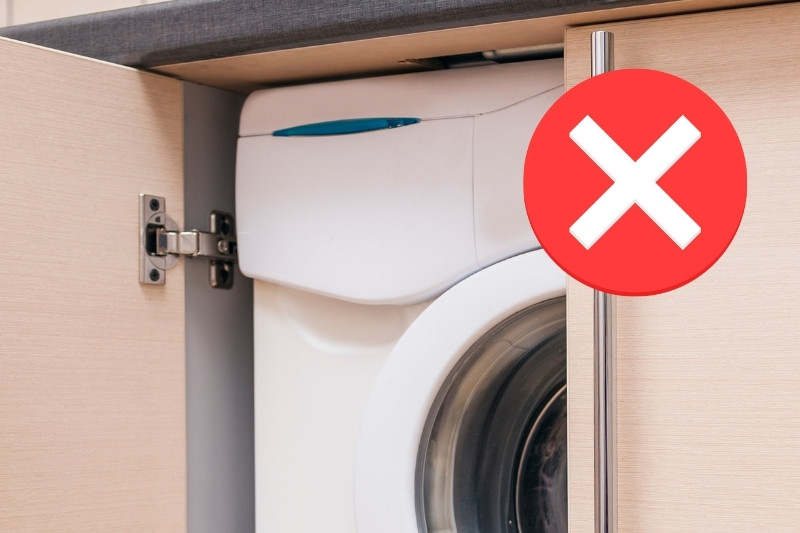
Generally speaking, most appliances need adequate air circulation to function properly. And if machines are subjected to poor air flow they typically start to heat up. A condenser tumble dryer is no different.
Any objects, cupboards or wooden panels that are placed near or right next door to a condenser tumble dryer can make it heat up.
To solve the problem at hand, you need to:
Make sure that enough air can circulate around your dryer. Try not to put anything flush against the dryer, like an oven and don’t cover the tumble dryer when it’s being used.
Proper ventilation is key!
Also, you should make sure that the ambient temperature in the room where the condenser dryer is housed is appropriate too. Sadly, if the temperature in the room is below 5℃ or is above 30℃ the dryer won’t function correctly.
Try and pick a suitable room that has an average temperature that is between these figures – that’ll give you the best chance of success.
Cause 7: Overloading the Dryer
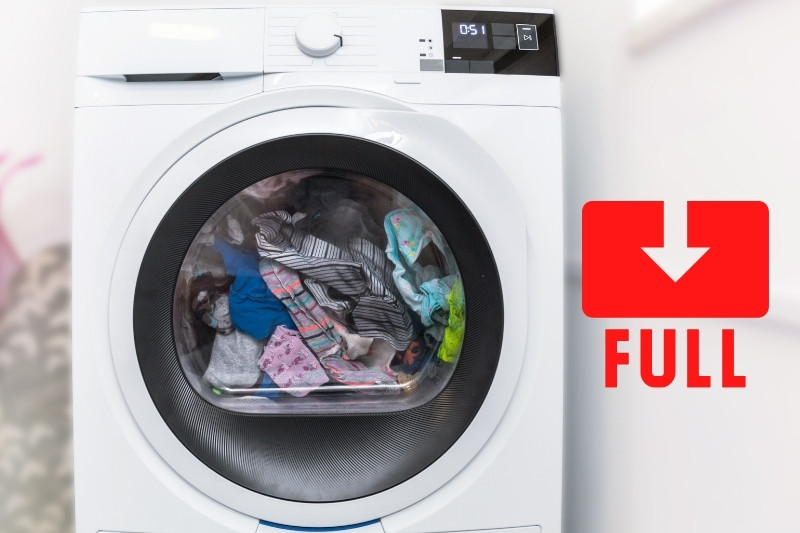
While it may seem like a good idea to stuff all your laundry into your little tumble dryer all at once, you should think again.
Overloading tumble dryers is always a bad idea. Not only does it put needless strain on the mechanical aspects of the appliance, but it can also overwork and stress the machine out, which can cause overheating.
To prevent this issue from causing more harm, do this:
Re-read your user handbook to remind yourself about how much laundry you can actually dry in the tumble dryer at once.
When you know the figure, you then need to weigh out your laundry, so you can work out how much washing you should pop into the machine at any given time. Only after you’ve done this can you start a cycle.
Don’t even consider overloading the machine, because that’s a sure way of shortening your dryer’s life, and causing more problems for it.
Cause 8: The Tumble Dryer Has Already Overheated and Needs to Be Reset
If you’re lucky enough, and your dryer has only overheated one time, you might just need to reset your tumble dryer to get it working as it should again.
To solve this problem, you need to:
Cut the power to your condenser tumble dryer and unplug it from the mains. Allow the machine to rest for a few minutes in this state, then replace the plug and put the power back on.
If you’ve got a modern tumble dryer, there may be a ‘reset’ feature built into your appliance. If you believe this to be the case, read your user manual to check what sequence of buttons you need to press to reset the dryer.
Seeking Additional Support

If you’ve tried and tested the solutions above, but you’re still not having any luck cooling down your dryer, you should think about calling in professional help.
If your condenser tumble dryer is still under warranty, you should call up the company for further advice. Or if you’d prefer to have a chat with someone at the shop you bought the appliance from, you should do so.
In the event that your tumble dryer’s warranty has run out, you should look into tumble dryer repair specialists in your area. They should be able to come out, check your machine and give you a quote for the work.
But always remember to do your homework before agreeing to anything.
How to Prevent a Tumble Dryer from Overheating
Nobody wants their condenser tumble dryer to randomly stop working! So, here are a few tips to help you keep the pesky overheating problems at bay:
- Clean and maintain the tumble dryer regularly – remove and clean the condenser box, the water tank and the filter often!
- Don’t overfill the dryer with wet laundry – stick to the capacity guide!
- Use the small nozzle on the hoover to remove any fluff from the tumble dryer – use it to reach into and clear out all the nooks you can’t get to.
- Inspect the dryer regularly to check for defects or potential issues.
- Make sure the dryer has enough ventilation.
- Don’t ignore the dryer when it tells you something is wrong – disregarding error messages or burning smells can be fatal!
Why Does My Condenser Dryer Keep Stopping?
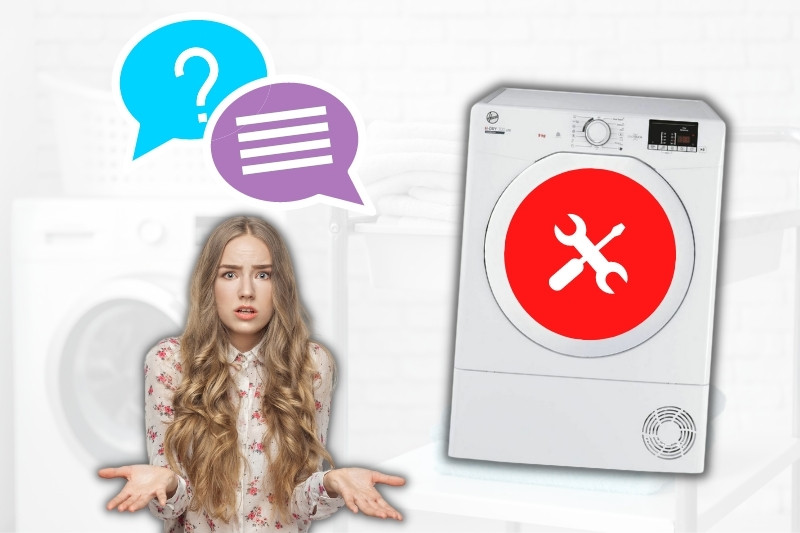
There are a number of reasons why your condenser tumble dryer might be stopping. These include the following:
- The water reservoir needs to be emptied
- You’ve opened the door mid-cycle too many times
- The moisture sensor in the dryer is filthy
- You’ve not added enough laundry or you’ve added too much laundry to the machine
- There could be some malfunctioning happening within the appliance
And while this list may sound extensive, you’ll be pleased to hear that most of these problems can be ironed out fairly quickly, and at a reasonable cost too.
Read our in depth guide on how to get your dryer working again if you need help.
Why Isn’t My Condenser Tumble Dryer Heating Up?
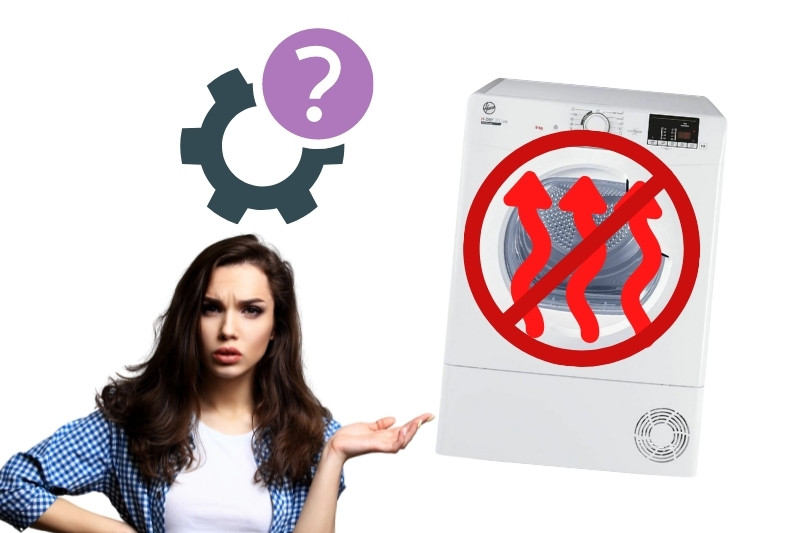
A condenser tumble dryer that doesn’t heat up, doesn’t really fulfil its duty! And although it may seem like a nuisance to you at first, there’s usually a really good reason why your dryer isn’t functioning as it should.
A condenser dryer may not be heating up because parts have started to malfunction, the door has been opened mid-cycle, the appliance is too dirty to function correctly, or the dryer has been overfilled.
As you can see there are multiple reasons why a dryer might not heat up, and you might find that two or more reasons apply to you at once. But the good news is that most of these problems can be put right at once.
Read our guide on how to get your dryer to heat up properly if you need some tips.

Bethan has a passion for exploring, reading, cooking and gardening! When she’s not creating culinary delights for her family, she’s concocting potions to keep her house clean!

